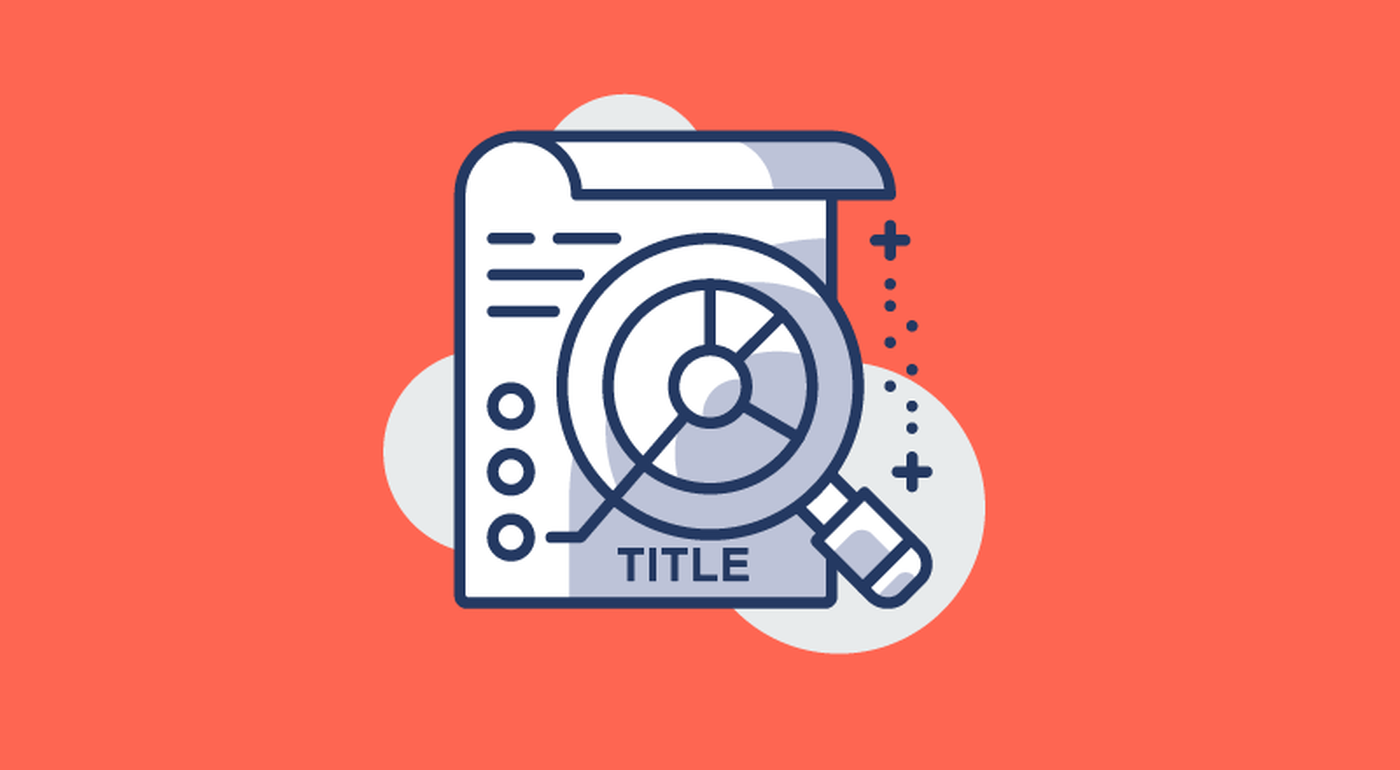Do you want to know the ultimate content marketing strategy for the 21st century and increase the return on investment of your content? Then don't miss what follows! Copywriting is the art of writing a text that, while touching the reader's emotions, significantly improves your engagement and conversion rates. In this ultimate guide, I share the following information with you:
- The complete definition of copywriting
- 6 good reasons to do copywriting
- 4 types of copywriting
- The 9 most effective copywriting techniques
- The 6 best tips for writing effective text
- 4 ways to write a compelling headline.
❓ Definition of copywriting
Copywriting is a writing technique that you should use if you want to inform, inspire, or persuade your reader. As a result, it is often used to increase sales and conversion rates for your prospects. This type of writing is typically used in advertisements, newsletters, blog articles, and social media posts.
The direct translation of this English term is not entirely explicit in French ("text writing"), so this word has entered our everyday language. However, you will sometimes find it formulated in different ways: "advertising writing", "concept-writing" or "persuasive writing".
Although copywriting is widely used in modern content marketing, this writing method is not new. It is believed to have appeared at the beginning of the 20th century. However, it was not until the rise of consumer society in the 1950s that copywriting became essential.
💥 6 good reasons to do copywriting
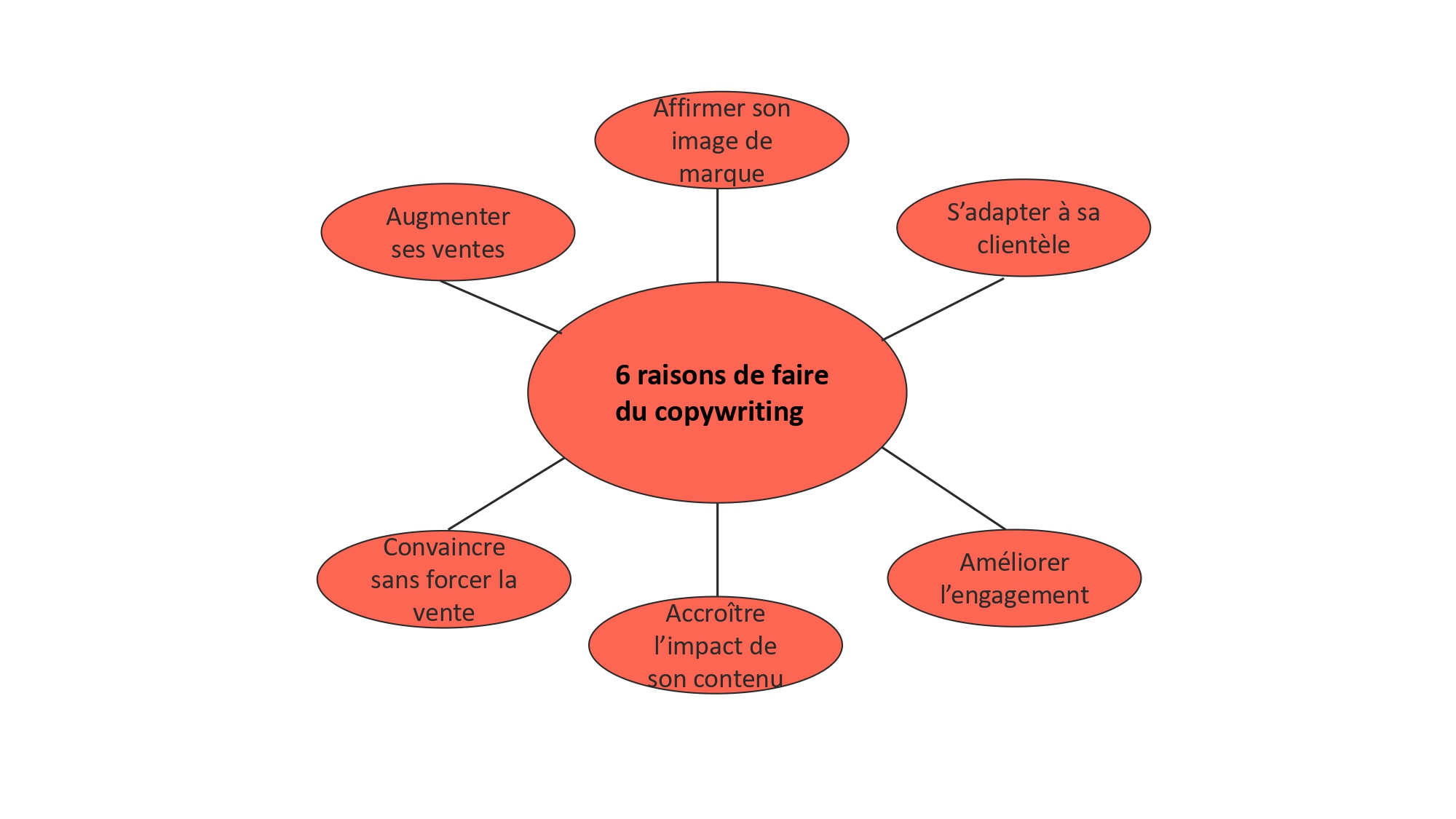
Whether you are creating your brand or looking to increase your current revenue, there are at least 6 good reasons to do copywriting! In addition to optimizing the SEO of your content (which improves the visibility of your site on search engines), copywriting your texts can significantly increase your organic traffic.
1. Assert your brand image
Copywriting is an excellent way to differentiate yourself from your competition on the Internet. By asserting your brand image, you allow your audience to clearly identify your company. This is especially important today, given the ever-growing amount of information and advertisements.
Taking the example of Nike, now famous for its slogan "Just Do It", you will notice that the brand often uses a current topic to promote its products. It continually tries to inspire its audience and pushes its public to believe in something and to give themselves the means to achieve it.
2. Adapt to your clientele
By doing copywriting, you are in constant analysis of your target customer. Indeed, to reach your audience and push them to action, you must perfectly understand their personality. As a result, this writing technique is an excellent way to know your buyer persona accurately and continuously.
As a reminder, this is essential work for content creation, whether for storytelling or SEO writing. This step is also essential for setting up a high-performance SEO strategy. This continuous monitoring is therefore very important for the adaptation and overall marketing strategy!
3. Improve engagement rate
As a preview of what will be explained in detail later in this article, copywriting is writing that focuses on the emotions and needs of your readers. Its influence on the engagement rate is thus extremely powerful. While strengthening the bond with your reader, you unconsciously push them to take a stand and interact. This is particularly effective on social media!
However, the importance of engagement on your website is just as important and often leads to an improvement in your revenue. Its effectiveness is also formidable in terms of engagement observed in the various phases of sales funnels.
4. Increase the impact of your content
If you create content, it's not only because you want it to be read, but also because it brings something to your audience and your business. With good copywriting, the impact of your sales pages, blog articles, and newsletters fully achieves this triple objective.
Indeed, by captivating your reader, you create an opportunity to reach your target with unparalleled efficiency. Moreover, this commercial writing technique clearly helps to structure your texts very precisely and forces you to adapt your writing style to your audience.
5. Convince without pushing for a sale
In web marketing, pushing for a sale is now completely outdated. The buyer wants to make their own decisions: they research, compare, and choose the product that suits them. This is exactly why online sales techniques are increasingly turning towards an indirect sales method.
To achieve this, you publish high-quality content with added value to establish a strong connection with your reader. Transparently, you offer concrete solutions to real problems, without directly promoting your products! And for that, copywriting is a formidable weapon!
6. Increase sales
Finally, thanks to the five reasons mentioned above, you achieve your ultimate goal: selling your product or service. Because there is no doubt that copywriting has a clear commercial purpose! This technique is therefore particularly effective for all your internet marketing campaigns: SEA, SEO, prospecting, sales funnel, and social media posts.
By respecting your audience and following the many tips you will discover as you continue reading, you can then put all the chances on your side to significantly increase your long-term revenue.
🍀 4 types of copywriting
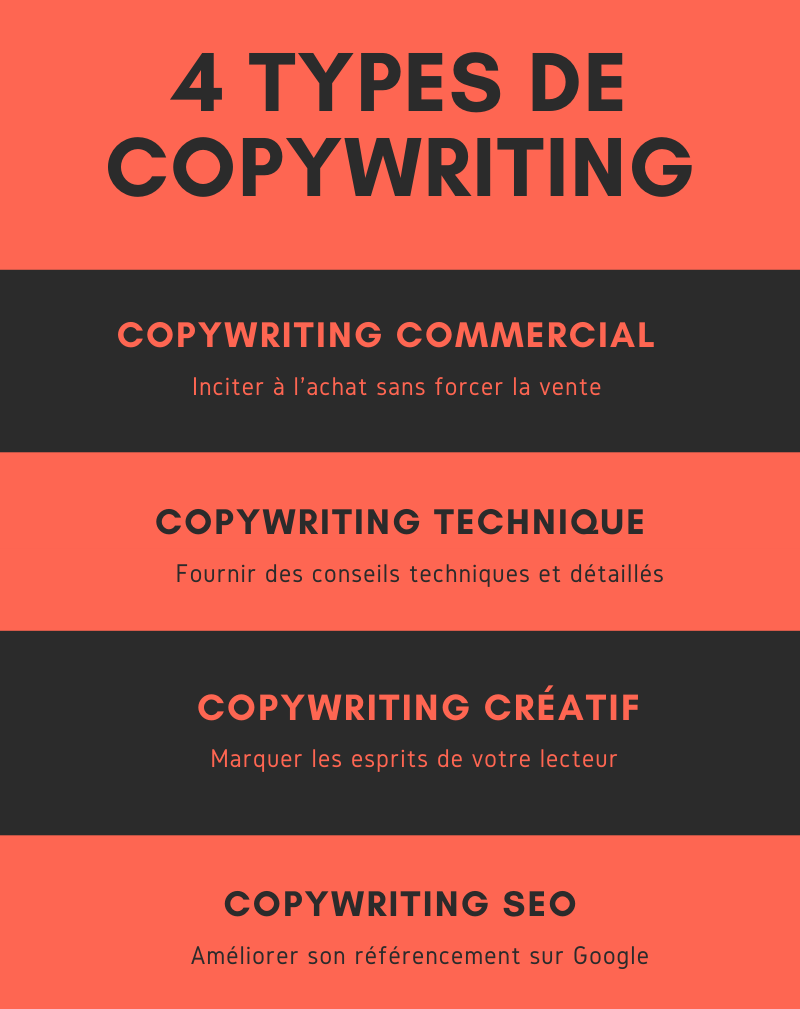
Depending on your goal, there are 4 distinct types of copywriting. However, you will use this content writing technique each time to reach your audience by offering them quality texts. Not only do you increase your chances of improving your natural referencing, but you also significantly expand your clientele. Here are my tips for achieving this based on what you want to offer.
1. Commercial copywriting
Your goal is clearly to encourage purchasing! But to promote your service or product without forcing the consumer, I recommend considering the following elements:
- address your reader;
- describe the problem precisely;
- detail the lack of previous solutions;
- clearly present your solution;
- make a powerful call to action;
2. Technical copywriting
This type of copywriting is used when you are addressing a knowledgeable audience or doing B2B. You then offer precise and detailed technical advice of high quality. As you are addressing other experts, your level of knowledge must be extremely high and your sources infallible. Most often, this type of content is particularly suitable for:
- review articles;
- user manuals;
- technical blogs;
- advertisements.
3. Creative copywriting
Of course, the goal of creative copywriting is also commercial. However, this time you are not looking to detail all the needs of your client. Indeed, you will mainly work on the impact of your company's image and make a lasting impression. This is typically the style of copywriting you will use when:
- you need to create a slogan;
- you want to write a headline;
- you want to propose an innovative concept.
4. SEO copywriting
Some people think that copywriting and natural referencing are not complementary; I think the opposite! Indeed, by adding value to your content, you clearly meet Google's expectations. Even if the SEO writer focuses on keywords while the copywriter is more interested in touching the reader's emotions, the writing techniques are similar in many ways:
- respond to search intent;
- structure information according to digital reading;
- reduce sentence length;
- push for action.
🌪 9 copywriting techniques
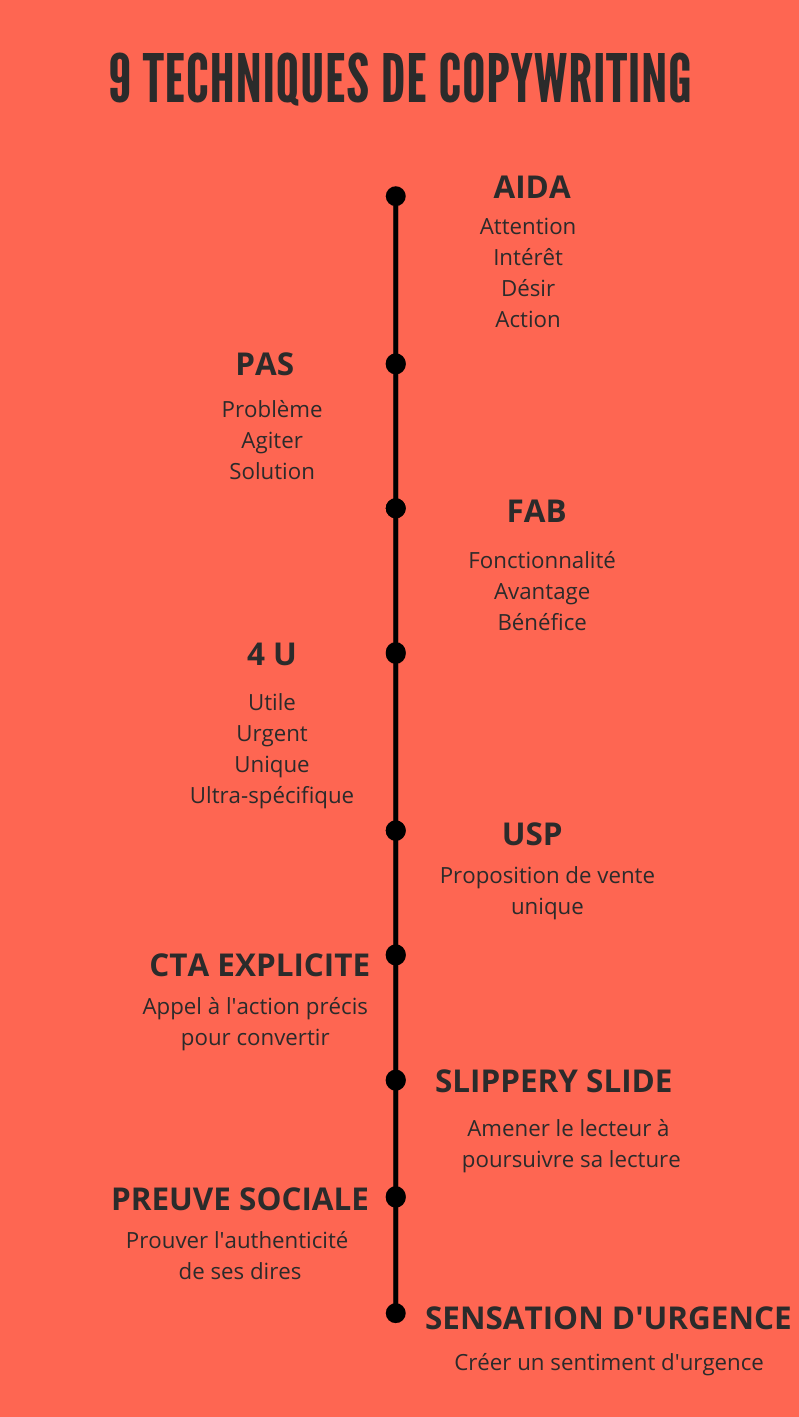
There are many ways to copywrite a text. However, 9 distinct techniques stand out. Sometimes complementary, sometimes only intended for certain types of writing, all the methods proposed below are truly effective in copywriting.
1. AIDA
This technique is extremely widespread in web writing, especially in copywriting. It allows you to properly structure your text and captivate your reader. Moreover, it is a very effective way to improve your conversion rate. AIDA is an acronym for:
- Attention: capture attention from the first few sentences.
- Interest: gain interest by proposing an innovative solution.
- Desire: arouse the desire to know more.
- Action: push for action.
2. PAS
Here is another method that is unavoidable in copywriting. Moreover, it is particularly easy to understand and implement. The PAS technique (from the English Problem, Agitate, Solve) can be translated as follows:
- Problem: identify the problem addressed in your content.
- Agitate: describe the problem to bring out emotions in your reader (negative aspect).
- Solution: finally propose your solution (positive aspect).
3. FAB
The FAB method is used in copywriting mainly when you are addressing an existing clientele. It allows you to present new products or services with formidable efficiency. Behind these three letters lies the following principle:
- Functionality: put forward your proposal.
- Advantage: detail its usefulness.
- Benefit: advance the advantage of your offer.
4. UUUU
The 4 "U" formula is particularly an excellent ally for generating a high engagement rate. However, it is also very effective if you apply it to the writing of your landing pages. Here's what these four letters represent:
- Useful: explain the concrete usefulness of your offer.
- Urgent: create a sense of urgency for decision-making.
- Unique: prove the uniqueness of your solution.
- Ultra-specific: demonstrate how well your proposal is suited to a particular situation.
5. USP
USP comes from the three English words Unique Selling Proposition, which means "unique selling proposition". This copywriting technique aims to answer the following question: why should people buy from YOU? You can then highlight your incomparable assets such as:
- your unbeatable prices;
- your fast delivery;
- your unmatched guarantees;
- your incomparable results;
- your exceptional customer service;
- etc.
6. Explicit CTA
If you want to convert your audience, you need to push them to act. By making a clear and precise call to action at the end of the page, you remind your reader that they can become an actor in their success. This technique is very common in SEO to retain traffic as long as possible.
In copywriting, this method is the ultimate goal of everything that has preceded it. It is therefore a crucial element not to be overlooked!
7. The slide
Known in English as the "slippery slide" (slippery slide), the slide is a copywriting writing technique that leads the reader to naturally continue reading. It is essential because your goal is for your reader to read your entire text and still be present when you offer them a call to action. Here is a diagram that describes this process.
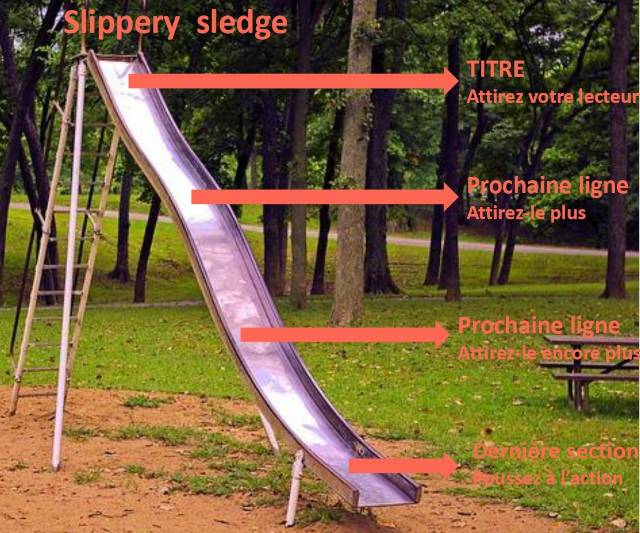
8. Social proof
In the field of copywriting, social proof is used to confirm the authenticity of your claims. You therefore provide irrefutable evidence of the benefits of the offer you propose. There are several ways to achieve this, but the most common are:
- Add certified testimonials.
- Offer verified study results.
- Propose usage statistics.
9. The sense of urgency
Are you launching a new offer or proposing a one-time action? Then the sense of urgency can certainly be your best ally for increasing sales! You can use this process in both paid advertisements and newsletters or on a sales page. Here are some tips for creating this sense of urgency that will convert your reader into a customer:
- limited-time offer;
- sale ends in X hours/days;
- opportunity not to be missed;
- limited quantity;
- only X products left
- etc.
✒ 6 tips for writing convincing text
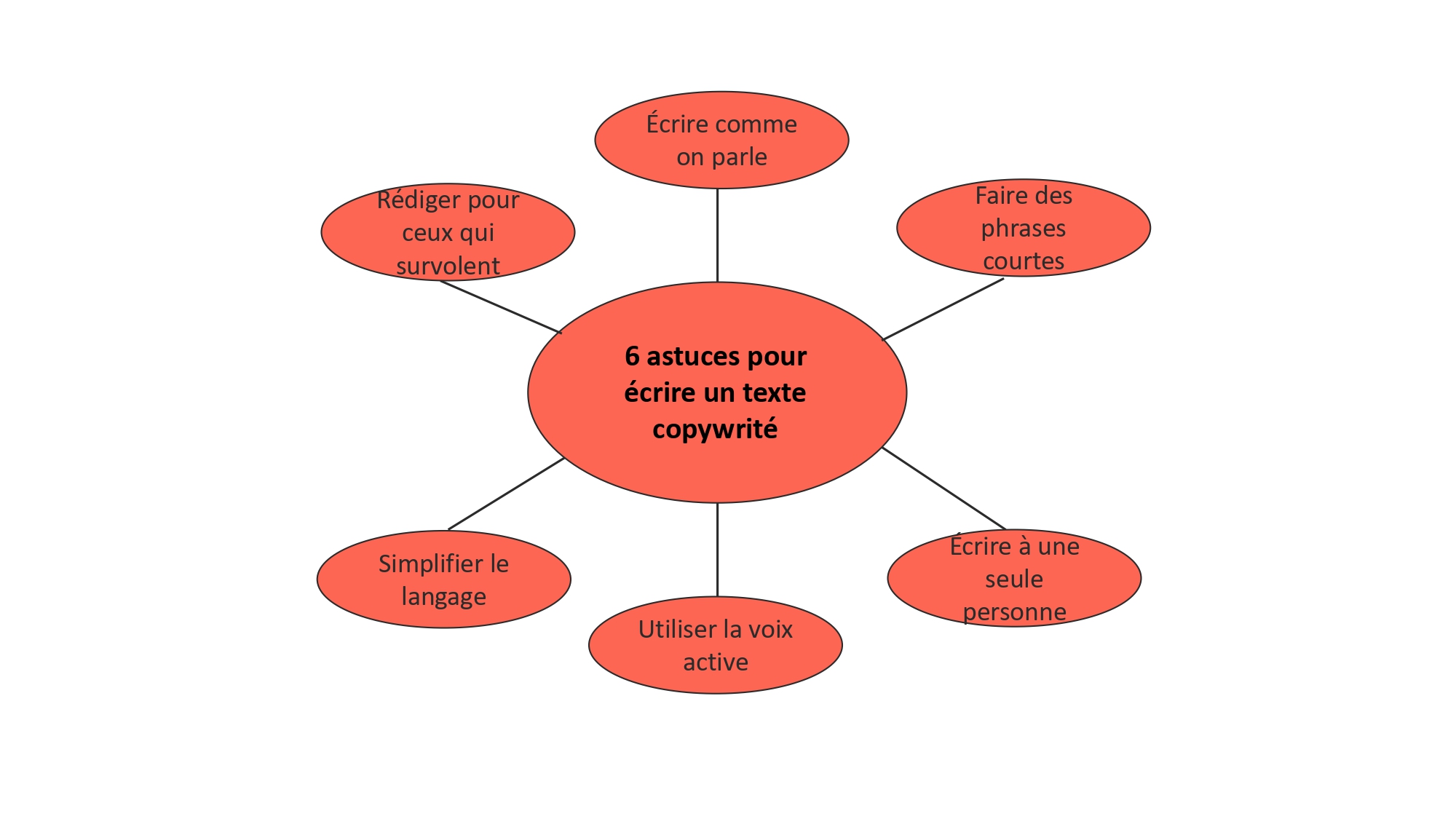
You now know all the most effective copywriting techniques. However, to write a high-performing text, you still need to be able to write it optimally. In this chapter, I offer you 6 writing tips for creating content that converts (which, of course, does not replace copywriting training!).
1. Write as you speak
Be natural! Although you are trying to meet the needs of your reader, they must also meet your expectations. Having previously established your editorial line for your content strategy, you will simply adapt your text to your way of expressing yourself.
To achieve this, an excellent way is to have a third party (or an application) read your text aloud. By listening to it, you will quickly realize whether your content is pleasant to the ear. If you are not entirely satisfied, you can then revise the parts that do not sound good.
2. Write short sentences
In web writing, and especially in copywriting, the length of sentences is a crucial element for conveying your message. First, digital reading on mobile phones or tablets offers only limited display space, making it uncomfortable to read long sentences. Moreover, your reader is easily subject to many sources of distraction, which can quickly make them lose track of their reading.
An extremely effective method for shortening your sentences is to limit yourself to one idea per sentence. However, this does not mean that you should restrict yourself to using only about twenty words per sentence. Indeed, you can play with the reading rhythm by playing with punctuation and sentence length.
3. Write to one person
By addressing the reader directly rather than a group, your audience can appropriate the text they read. As a result, if the reader feels personally concerned by the content, they are much more likely to let their emotions go. And as you have understood, this is the very basis of copywriting!
Although this may seem obvious in a B2C commercial strategy, the same applies to B2B. And many writers forget this! I strongly advise you to avoid addressing too broad an audience and always try to personalize your writing.
4. Use active voice
If you want your readership to feel involved in what you write, you should try to minimize the use of passive voice. Indeed, the human brain works in such a way that active voice allows it to identify much better with a subject or imagine a concrete image.
If you are not sure what this means, here is the definition of active voice in Larousse.

5. Simplify language
Of course, the technicality of the language you use depends entirely on the target audience. However, in general, do not try to impress by using overly elaborate vocabulary. Even if you are addressing experts, you will try to simplify your speech as much as possible.
For your copywriting to be impactful, you must allow your reader to feel emotions and identify with the subject discussed. If you use complicated language, this significantly reduces their intellectual abilities to achieve the desired goal.
6. Write for those who skim your content
Once again, you must adapt your writing to the reality of digital reading! Indeed, a digital reader will tend to skim a text to find the information they are looking for directly or to know if the text will answer their question.
To achieve this result, you will need to write relevant subtitles, space out your text, bold words, use bulleted lists, or even offer complete infographics. The use of hypertext links not only improves your internal linking but also offers an exit door for your reader if this subject is exactly what they need.
🚀 4 ways to write a compelling headline
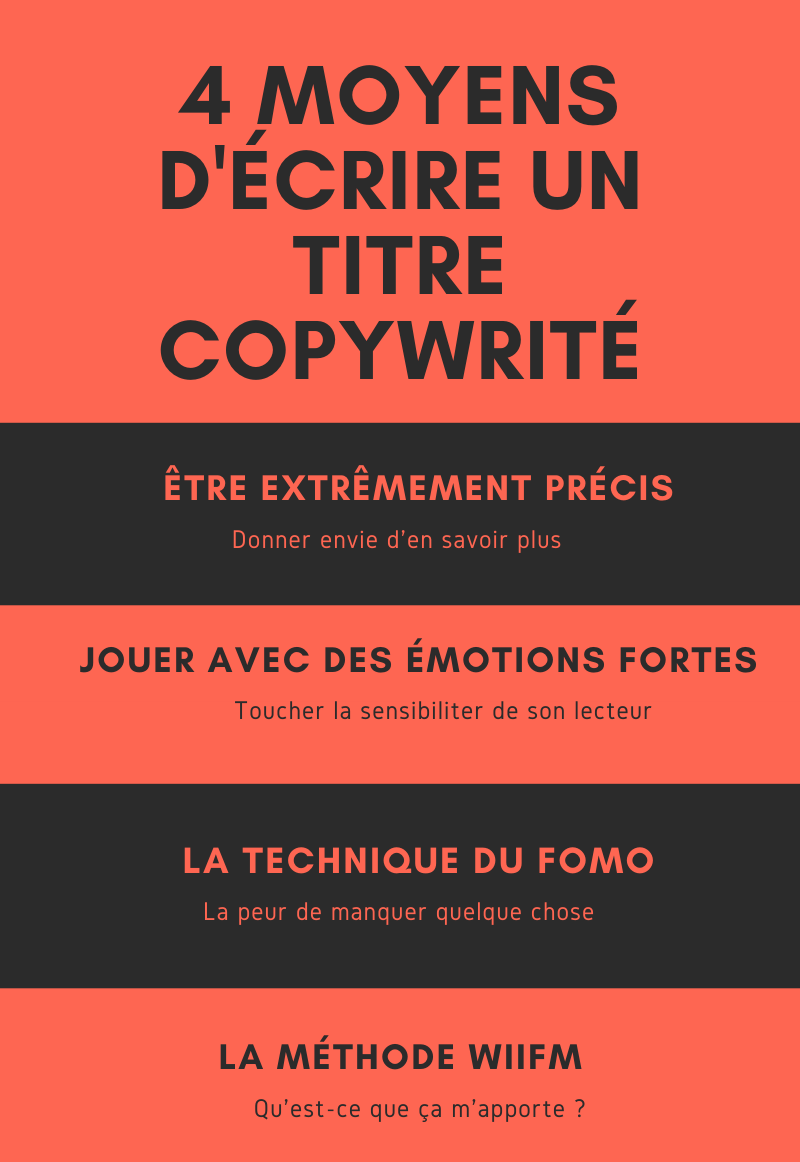
To do good copywriting, you must pay particular attention to the introduction (to make the reader want to read the content) and the conclusion (for the call to action). However, the importance of titles (H and H1) is essential for your reader to agree to read the content of your text. Here are 4 methods for writing compelling headlines.
1. Be extremely precise
The precision of your title is essential for your referencing and must make your audience want to know more. It must describe exactly what the reader will get by reading your text. If you remain vague or if the first lines do not correspond to your title, you are likely to lose your reader!
For example, if your title is "Make Money on the Internet", your promise is interesting but remains vague. If, on the other hand, your title is "7 Tips to Earn $200 a Day on the Internet", your offer is much more precise and will certainly lead more readers to want to read your article.
2. Play with strong emotions
The performance of a copywritten text is entirely related to the impact it has on the reader's feelings. That's why touching sensitivity in the title is an excellent copywriting technique. To achieve this result, it is recommended to use terms that create emotions in Internet users. Here are some examples (to be used in both masculine and feminine forms):
- crazy;
- exceptional;
- new;
- now;
- incomparable;
- mistake;
- tip;
- fast;
- …
3. The FOMO technique
The FOMO technique comes from the English "fear of missing out", which means: the fear of missing something. Of course, this process cannot be applied in all situations. However, if it corresponds to your content, I advise you not to forget it! Indeed, it is extremely effective in reaching the emotions of your readership.
For example, copywritten titles like "Don't miss this exceptional 24-hour offer" have a very high opening rate for newsletters or paid advertisements.
4. The WIIFM method
Once again, this is an English-speaking method that works very well in copywriting. This acronym stands for "What's in it for me", which means in French: what does it bring me.
To illustrate this copywriting concept, a common mistake is that the title talks about the company (for example: "We have been the kings of computing since 2010"). Honestly, this does not interest the Internet user! However, if you transform this title into "Find the computer you need", your click-through rate will certainly skyrocket!
In commercial communication, copywriting is an extremely powerful technique. It allows you to play with the reader's emotions in order to push them to make a purchase, without forcing their hand. If you want to increase your revenue, it is necessarily an element to consider in your web marketing strategy. By following the advice I have just given you, you will be able to:
- copywrite the title of your texts to increase your traffic and click-through rate;
- write your content to captivate your audience in order to improve your engagement and conversion rates;
- adapt the techniques offered according to the type of content you write;
- see your revenue soar and stand out from your competition.
To put all these processes into practice, you could, for example, start creating a white paper right now!
Need to go further?
If you need to delve deeper into the topic, the editorial team recommends the following 5 contents:
